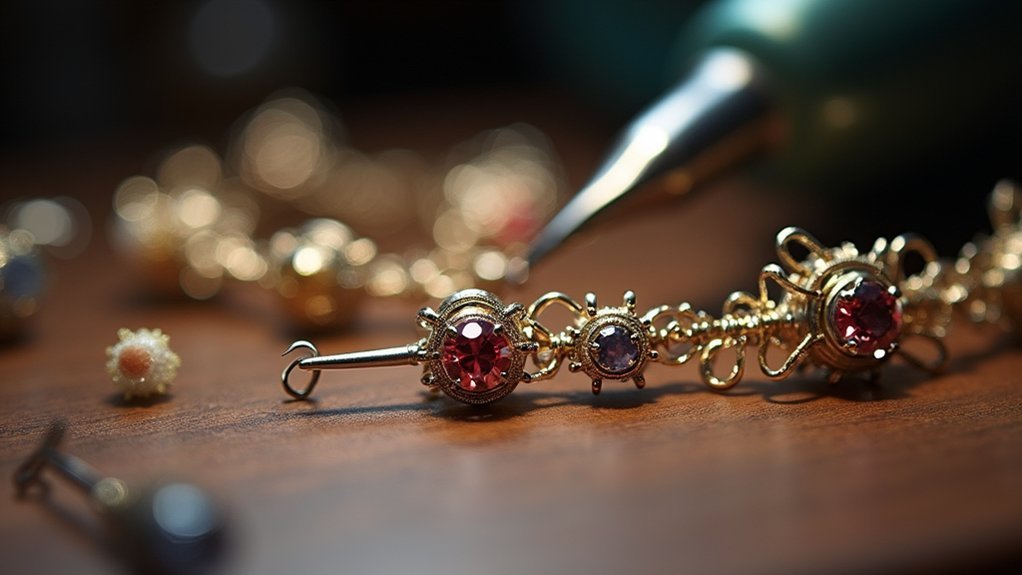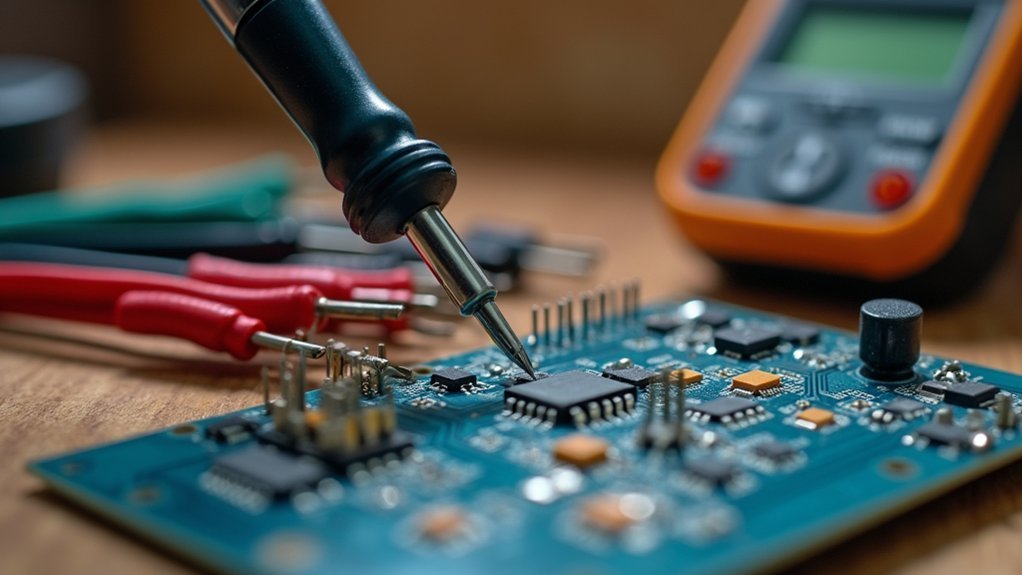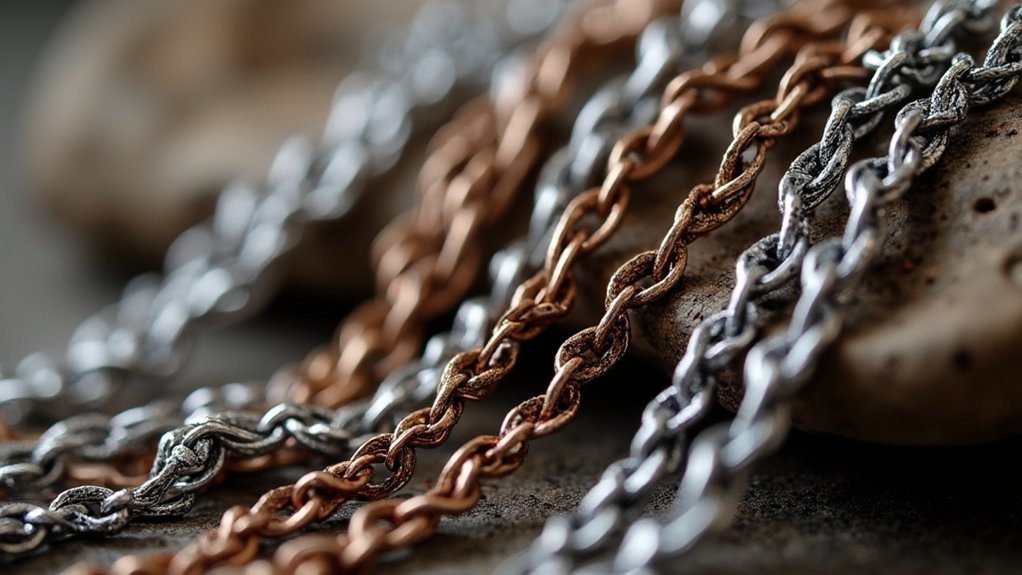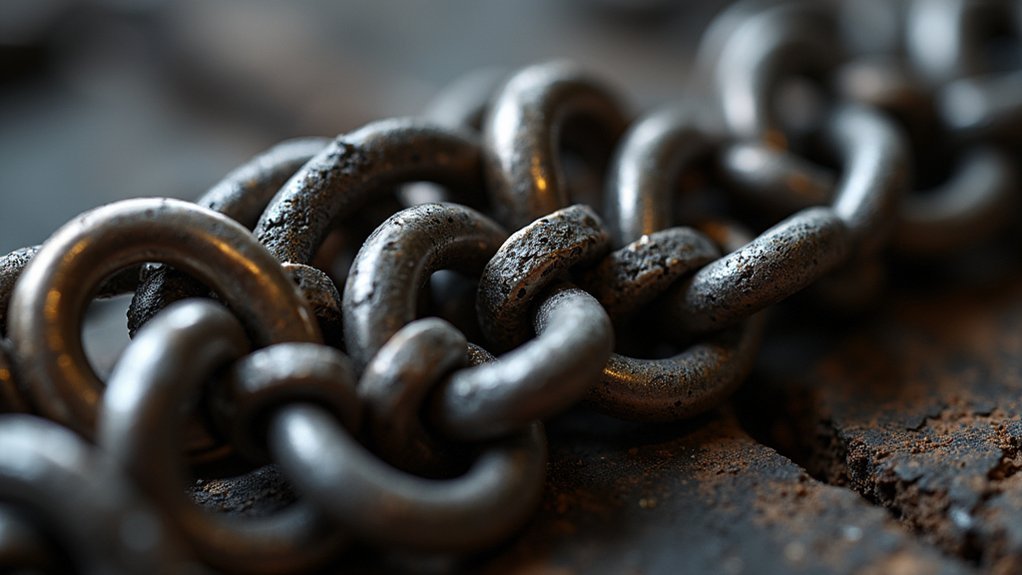You’ll achieve professional soldering success by mastering temperature control between 350°C-400°C, applying flux precisely to eliminate oxidation, and keeping heat application under three seconds to prevent thermal shock. Use specialized tweezers for delicate placement, follow proper multi-joint sequences from hard to easy solder, and implement heat sinks to protect sensitive components. Maintain your tools by regularly cleaning and re-tinning tips, while practicing burst soldering techniques for ideal control. These foundational techniques reveal advanced methods that’ll elevate your craftsmanship.
Mastering Temperature Control for Delicate Jewelry Components

When working with delicate jewelry components, you’ll need to master precise temperature control to avoid damaging precious metals and stones while achieving strong, clean solder joints.
Maintain your soldering iron between 350°C and 400°C for ideal heat transfer without thermal damage. Choose a fine soldering iron tip for precise application and implement safety measures like heat sinks to protect surrounding areas.
Precise temperature control between 350°C-400°C with fine tips and heat sinks prevents thermal damage while ensuring clean jewelry solder joints.
Master the drag soldering technique for better control over solder application, ensuring you only heat intended areas.
Regular cleaning and tinning of your iron tip enhances performance and reduces heating time. Consider lead-free alternatives when working with valuable pieces, as they often require slightly different temperature control approaches for successful bonding.
Precision Flux Application Techniques for Clean Metal Joints
Although temperature control forms the foundation of quality soldering, flux application determines whether you’ll achieve truly professional results in your jewelry work.
You’ll need to apply flux precisely to eliminate oxidation from metal surfaces, ensuring ideal solder flow and adhesion. When you heat your work to 1,100°F, properly applied flux turns clear and glassy, signaling effective melting conditions.
Select the right flux type for your project. Rosin flux works well for general applications, while no-clean formulations reduce post-soldering cleanup. Water-soluble options offer the strongest cleaning action for heavily oxidized metals.
Apply flux frequently since it burns off quickly during soldering. Adequate coverage improves heat conduction contact area and prevents cold joints.
Clean joints depend on maintaining flux protection throughout the entire soldering process.
Advanced Surface Mount Soldering for Miniature Jewelry Elements

When you’re working with miniature jewelry elements, you’ll need to master precise component placement techniques that account for the extremely small scale and delicate nature of these parts.
You must develop exceptional heat control skills to prevent damage to sensitive materials while ensuring proper solder flow and joint formation.
Your success depends on maintaining steady hands and using specialized tools that allow you to manipulate tiny components with millimeter-level accuracy.
Precision Component Placement Techniques
Miniature jewelry elements demand surgical precision when placing surface mount components, as even microscopic misalignments can compromise both functionality and aesthetic appeal.
You’ll need specialized tweezers or vacuum pick-up tools to achieve accurate precision component placement while maintaining complete control over delicate parts. A microscope or magnifying glass becomes essential for visualizing tiny details during positioning.
Before soldering, apply thin flux layers to both pads and component leads to enhance solder wetting and adhesion.
Your hot air rework station will evenly heat components and pads, allowing solder to flow properly without damaging surrounding areas. These soldering tips guarantee ideal electrical connections while preserving the intricate beauty of your miniature jewelry designs through careful temperature control and precise positioning techniques.
Heat Control for Delicate Elements
Because delicate surface mount components in miniature jewelry can suffer irreversible damage from excessive heat, you’ll need to master precise temperature control between 350°C to 370°C on your soldering iron. This narrow temperature window guarantees ideal solder flow without thermal damage.
Use a fine-tipped soldering iron for precise soldering on intricate parts. Advanced techniques like drag soldering create clean joints by placing solder on the tip and gently dragging across component leads. This method minimizes heat exposure while maintaining consistent results.
Implement heat sinks or clamps on sensitive components to absorb excess heat during the process. Clean your iron tip regularly and apply high-quality flux to improve solder adhesion.
These heat control strategies protect delicate elements while achieving professional-grade connections in miniature jewelry applications.
Professional Desoldering Methods for Jewelry Repair and Rework
Professional jewelry repair demands precise desoldering techniques that protect delicate metals while effectively removing unwanted solder.
You’ll achieve best results using a desoldering pump or solder sucker with quick, precise application before solder solidifies. Hot air rework stations provide superior heat distribution, minimizing risks to sensitive jewelry components.
For complex removals, apply low-temperature alloy like Chipquik to keep solder liquid longer, enabling simultaneous component extraction. Use solder wick with proper flux to absorb excess material from tight spaces and enhance flow characteristics.
Always employ heat sinks or clamps on delicate areas to dissipate unwanted thermal energy. This protects surrounding metals while concentrating heat only where needed.
These professional methods guarantee successful jewelry repair without compromising structural integrity or aesthetic quality of precious pieces.
Heat Sink Strategies to Protect Gemstones and Sensitive Materials

When you’re soldering near gemstones and sensitive materials, you’ll need strategic heat sink placement to prevent costly damage.
Your choice of heat sink material—whether aluminum or copper—and its precise positioning can make the difference between a successful repair and a ruined piece.
You’ll also want to master temperature control methods that guarantee your heat sink maintains protective temperatures throughout the entire soldering process.
Heat Sink Materials
The delicate nature of gemstones and sensitive materials demands strategic heat management during soldering operations.
You’ll need heat sinks crafted from materials that excel at absorbing excess heat while protecting delicate components from thermal damage.
The most effective heat sink materials include:
- Copper – Offers superior thermal conductivity, making it ideal for rapidly drawing heat away from sensitive areas
- Aluminum – Lightweight yet effective, providing excellent heat dissipation for moderate temperature control
- Brass – Delivers reliable thermal management with good durability for repeated use
- Silver-plated options – Enhance thermal conductivity while preventing oxidation during extended soldering sessions
When applying a heat sink, you’re creating a thermal pathway that diverts dangerous heat buildup.
These materials guarantee your gemstones maintain their integrity while you complete precision soldering work.
Placement and Timing
Strategic placement of your heat sink determines whether you’ll successfully protect delicate gemstones or risk costly thermal damage. Position your heat sink in direct contact with the area being soldered to create an effective thermal barrier between your work and sensitive materials.
Timing is equally critical in the soldering process. Keep heat application under 3 seconds to prevent thermal shock. Monitor your gemstone’s temperature continuously and use low-temperature solder with a melting point around 217°C for maximum protection.
| Heat Sink Placement | Timing Guidelines |
|---|---|
| Direct contact with solder joint | Under 3 seconds heat application |
| Between heat source and gemstone | Continuous temperature monitoring |
| Maximum surface contact area | Use low-temperature solder |
| Secure positioning throughout process | Allow cooling between applications |
Temperature Control Methods
Although effective placement sets the foundation, proper temperature control methods will make or break your delicate soldering work. Your soldering iron’s tip requires adjustable temperature settings to prevent damage while maintaining proper solder flow.
With a steady hand and the right safety precautions, you’ll protect gemstones from high temperatures.
Essential temperature control strategies include:
- Heat sinks placement – Position metal clips near solder joints to absorb excess heat before it reaches sensitive materials
- Temperature fine-tuning – Use the lowest effective setting that still achieves lower melting point requirements
- Burst soldering technique – Apply heat in short intervals with cooling breaks between applications
- Wet cooling assistance – Place damp sponges near particularly delicate components for additional thermal protection
Multi-Joint Soldering Sequences for Complex Jewelry Assemblies

When you’re tackling complex jewelry assemblies with multiple solder joints, success hinges on your ability to orchestrate a precise sequence that prevents previously soldered connections from failing. Start with proper alignment and secure positioning of each joint to prevent movement during heating. Apply flux generously across all connection points to eliminate oxidation and enhance solder flow throughout your intricate designs.
| Joint Order | Solder Type | Heat Level |
|---|---|---|
| First | Hard solder | High |
| Second | Medium solder | Medium |
| Third | Easy solder | Low |
| Final | Low-temperature solder | Minimal |
Use tripods or holding fixtures for enhanced stability and superior heat distribution. Practice multi-joint soldering techniques on test pieces to develop timing and rhythm, ensuring each connection receives appropriate heat without compromising delicate components in your intricate designs.
Tool Maintenance and Tip Care for Consistent Professional Results
The foundation of professional soldering lies in meticulous tool maintenance, where your iron’s tip serves as the critical interface between heat source and joint. Your soldering quality depends entirely on proper tip care and consistent upkeep practices.
To maintain peak performance, follow these essential maintenance practices:
- Clean the soldering iron regularly using damp sponge or brass wool to guarantee effective heat transfer.
- Re-tinning the soldering iron tip after each use creates a protective layer that’ll prevent oxidation.
- Inspect soldering tips for pitting or dullness, replacing worn tips immediately to avoid component damage.
- Store soldering tools in dry environments with tip protectors to minimize corrosion.
Establish a maintenance schedule that includes cleaning, inspection, and re-tinning procedures. This routine guarantees consistent results in professional applications.
Frequently Asked Questions
What Is the Secret to Good Soldering?
You’ll achieve good soldering by maintaining precise temperature control between 350-400°C, using flux to prevent oxidation, ensuring proper joint alignment, mastering advanced techniques, and regularly cleaning your iron tip.
What Is the Number 1 Rule of Soldering?
You must guarantee proper fit and alignment of components before soldering. Gaps prevent solder from flowing correctly, creating weak joints that’ll fail. This fundamental rule determines whether you’ll achieve reliable, professional-quality connections.
How Can I Improve My Soldering Skills?
You’ll improve by practicing regularly to build muscle memory, mastering heat application timing, experimenting with different solder types, using magnification for precision, and learning from online communities and tutorials.
How to Do Professional Soldering?
You’ll achieve professional soldering by maintaining proper temperature control, using quality flux, mastering drag techniques, keeping your iron tip clean and tinned, and ensuring precise component alignment for strong, reliable joints.
In Summary
You’ve now mastered the seven essential techniques that’ll elevate your jewelry soldering from amateur to professional level. Remember, temperature control and proper flux application form your foundation, while advanced methods like SMT soldering and strategic heat sinking protect your valuable materials. Practice these multi-joint sequences regularly, maintain your tools meticulously, and you’ll consistently produce clean, precise joints. Your enhanced skills will transform complex repairs and intricate assemblies into manageable, successful projects.





Leave a Reply